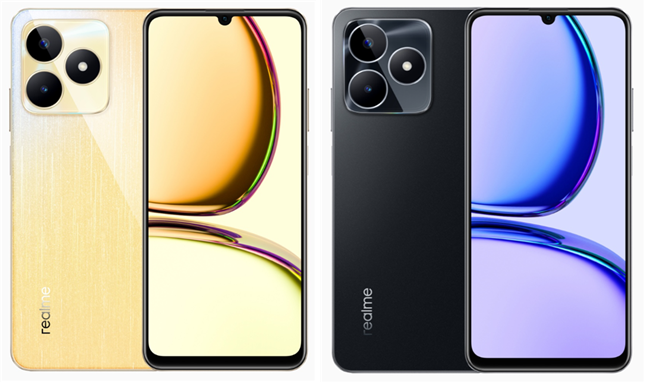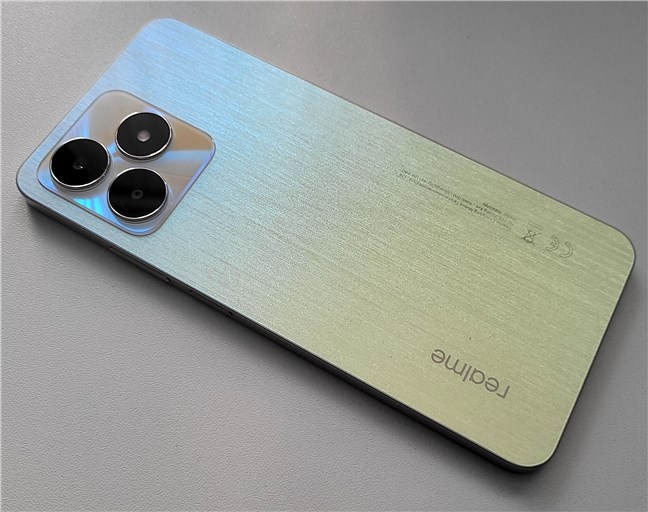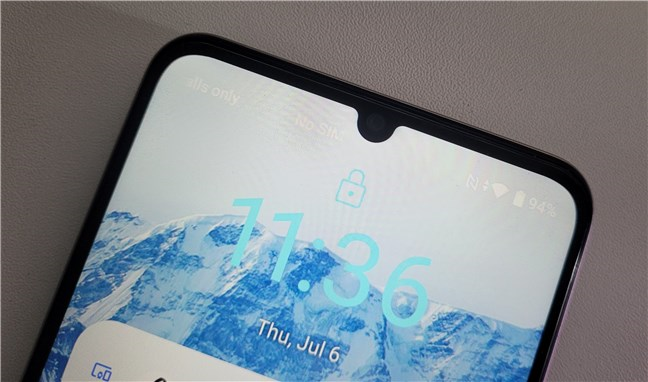
Are you, by any chance, looking for a smartphone with a big screen, a generous battery, decent performance, and a low price? Well, in that case, the new realme C53 might be just what you need. It’s an Android smartphone made by Realme, a Chinese company that manages to stand out both in the mid-range and the budget Android phone sector. In this review, I take a closer look at what the new realme C53 has to offer to help you get a better idea of whether or not it’s worth buying. Let’s get started:
realme C53: Who is it good for?
The realme C53 smartphone is a good choice if:
- You want a device with a good-looking design and a low price
- You’re mainly interested in a smartphone good for everyday activities
- You’re looking for a phone with long battery life and fast charging
Pros and cons
Here’s what I like about the realme C53:
- Smart and beautiful design
- Extra large screen
- Good battery life and fast charging
- Enough RAM and internal storage, plus a dedicated microSD card slot
- Affordable price
- Generous accessories package
There are some downsides to consider as well:
- Low resolution and dimly lit screen
- Inaccurate fingerprint sensor
- Underwhelming when taking photos or videos
- Poor performance in games
Verdict
The realme C53 is obviously an entry-level smartphone with an affordable price. But that doesn’t necessarily mean it’s not worth buying. Offering a nice design with a large screen, a generous battery, and decent performance in everyday activities, it can be a good choice for those who don’t have high expectations. I personally see it as an option to consider for grandparents or parents. But if you need something powerful enough for gaming or want a good phone for photos and video, you might be better off looking for alternatives.
Unboxing the realme C53
Like all the other realme smartphones I’ve had the joy of testing, the realme C53 arrives in a brightly colored box. The background is a vibrant yellow, and the text is black. This color scheme immediately catches the eye, and it somehow makes me think of bees every time. 🙂 The box’s top cover is minimalistic, featuring just the smartphone’s name and a message printed in small fonts in the top left corner, announcing the company as Europe’s fastest-growing brand.

The box of the realme C53
When you open the box, you find the phone (wrapped in a protective foil), a fast charger (33 watts) plus a detachable USB-A to C cable, a clear silicone protective cover, a tool for removing the SIM card tray, and a user manual including warranty details and safety information.

Unboxing the realme C53
The unboxing experience offered by the realme C53 smartphone is a pleasant one. Even though we’re dealing with an Android smartphone available for an affordable price, the package contains a fast charger and a protective case for the phone. The only thing missing are wired headphones (the smartphone has a 3.5mm audio jack).
Design and build quality
With a generous 6.74-inch (109.7 cm) screen, the realme C53 is a large smartphone. But despite its sheer size (167.3 x 76.7 x 7.5 mm or 6.59 x 3.02 x 0.30 inches in length x width x depth), it doesn’t weigh very much - just 182 grams or 6.42 oz. Considering how long and wide it is, I don’t think this smartphone makes a great choice for those with short fingers, like many teenagers, for instance.

Color versions for the realme C53
The back of the realme C53 appears to be covered in glass, but it’s actually plastic. Still, it’s a great-looking plastic material. The phone is available in two color versions: Champion Gold and Mighty Black. I tested the Champion Gold one, a model with a color scheme clearly designed to catch the eye. The back of the smartphone actually glows, creating the illusion of radiance and making the device feel more expensive than it really is.

The back of the realme C53
Speaking of the back of the smartphone, I have to say that the camera system looks really good. It seems inspired by iPhone models: in the top-left corner (viewing the phone from the back), you find three rings inside a shiny rectangular section. At first glance, you might think there are three cameras here, but in reality, we’re dealing with a design trick: only one of the rings holds the smartphone’s camera. Another houses a depth sensor, and the third ring is actually the LED flash.

Designul sistemului de camere de pe realme C53
Given that this is an affordable smartphone, the manufacturer compromised a bit on the device’s build. Besides using mostly plastics, the smartphone is not certified for dust or water protection. Furthermore, its screen is covered with durable glass, but not a familiar one like Gorilla Glass.
The edges of the screen are slightly rounded, but the screen is essentially flat and, as a matter of fact, the smartphone doesn’t come with a pre-applied screen protector. I find this last aspect odd because all the realme phones I’ve seen and tested in the past had screen protection applied out of the box.

The realme C53's screen is large
As you may have noticed in the above image, the dark edges (black borders) of the screen are not very wide, but they’re not small either. On the plus side, they’re relatively symmetrical, the only one slightly wider being the one in the lower part of the smartphone. Furthermore, at the top, the black border is interrupted in the middle area by the teardrop-shaped selfie camera cutout.

The selfie camera on the realme C53
Other than the SIM card slot, you won’t find anything else on the realme C53’s left edge.

The left side of the realme C53
On the right side of the realme C53, at the top, you find the volume buttons (monobloc) next to the power button, which also serves as a fingerprint sensor.

On the right, you find the volume buttons and the power/fingerprint one
The top edge of realme C53 is completely clean, without any elements. However, the lower side contains several elements: a speaker, the USB Type-C port used for data transfer and smartphone charging, the phone’s microphone, and a 3.5 mm headphone audio jack.

The lower edge of the realme C53
The realme C53 is a big and beautiful smartphone. Despite its affordable price, the phone looks stylish and is sure to catch the eye of those around you. Its designers have somehow managed to create a device that looks much more expensive than it actually is. However, they had to compromise to keep the price as low as possible.
Hardware specifications
The realme C53 is equipped with a Tiger T612 chipset, developed by Unisoc and launched in May 2022. This chipset is a 4G SoC (System on a Chip), built on a thin 12 nm manufacturing process, which includes an eight-core processor (two Cortex-A75 cores and six Cortex-A55 cores, all running at the same frequency of 1.80 GHz). On the graphics side, the chipset offers a Mali-G57 processing unit. When it comes to memory and internal storage, the smartphone is available in one configuration: 6 GB of RAM and 128 GB of internal flash memory.

realme C53: System details
Of the 128 GB of total storage space, you have about 99 GB free after installation. Of course, after performing all the available system and app updates, this value drops slightly. While I think the internal storage is enough for most users, the good news for those who need more is that the smartphone allows adding a microSD card. Moreover, even though the realme C53 is a dual SIM device that supports two nano-SIM cards simultaneously, the SIM holder includes a dedicated microSD card slot.

realme C53 is a dual SIM phone with microSD support
The realme C53’s display is based on an IPS LCD panel, offering nice colors and good contrast, but its resolution doesn’t impress, and its brightness isn’t great. With a 6.74-inch diagonal and a 20:9 aspect ratio, the screen resolution is 720 by 1600 pixels, resulting in a pixel density of around 260 ppi - a bit low, in my opinion. The maximum brightness provided by the screen is 560 nits (candela per square meter), which is OK in most cases, but low when you’re using the phone outside, in bright light. On the other hand, one thing I like about the smartphone is that the screen has an above-average refresh rate of 90 hertz. That translates into smoother transitions and motion pictures than a standard 60 Hz refresh rate.

The screen has low resolution but a 90 Hz refresh rate
When it comes to its cameras, the realme C53 offers:
- A main (wide) camera with a 50-megapixel sensor, f/1.8 aperture, and PDAF (phase-detection autofocus). This is accompanied by a depth sensor (depth camera), whose technical specs I couldn’t find details on.
- A front selfie camera using an 8-megapixel sensor with an f/2.0 aperture.
Both the main and front cameras are HDR compatible, and both can record video at 30 frames per second. The rear camera allows a maximum resolution of 1080p, while the selfie camera is limited to 720p. The smartphone unfortunately lacks image stabilization while filming.

The main camera has 50 megapixels
As for connectivity options, it’s worth mentioning that the realme C53 can connect to dual-band Wi-Fi 5 (802.11 a/b/g/n/ac) networks on the 2.4 and 5 GHz bands. It is not compatible with Wi-Fi 6. The phone supports Bluetooth 5.0 and NFC (in some parts of the world). Additionally, the smartphone includes a fingerprint sensor (on the power button), as well as other useful sensors like an accelerometer, a proximity sensor, a compass, and a gyroscope.

The realme C53 supports Wi-Fi 5
realme C53 is powered by a non-removable Li-Po battery with a generous 5000 mAh capacity. An unexpected detail for a smartphone in its price range is its support for 33-watt fast charging. The package includes the appropriate charger, which, in theory, is capable of charging 50% of the battery in 31 minutes. I will elaborate on this in the next section.

The realme C53 comes with a 33W fast charger
If you want details on all the features and technical specs, check out the official webpage for realme C53.
The realme C53 official specs tell the story of an Android smartphone that should be able to provide a good user experience in everyday activities. While it’s not a powerful phone, the hardware is good enough for everyday tasks. It doesn’t seem to be a device suitable for those who want to play games or for photography enthusiasts.
Visit the next page of this review to read more about the user experience offered by the realme C53, its camera quality, its benchmark performance, and the software you get with this smartphone.


 10.07.2023
10.07.2023 


